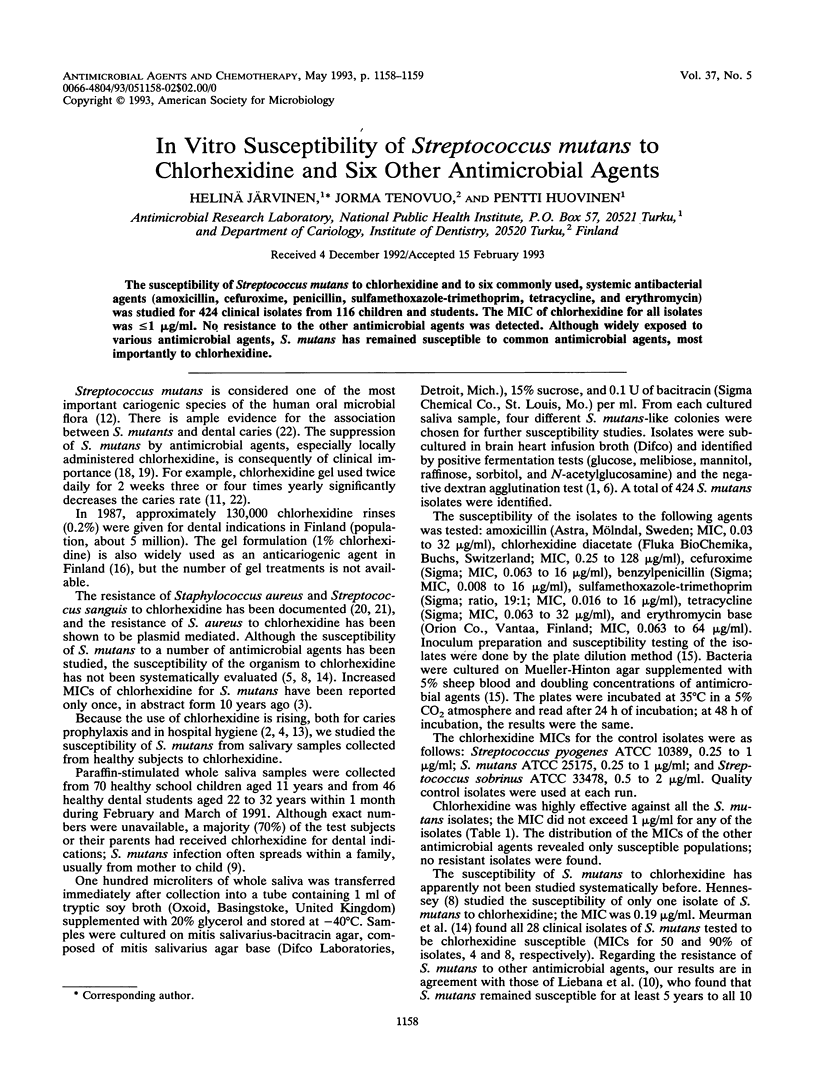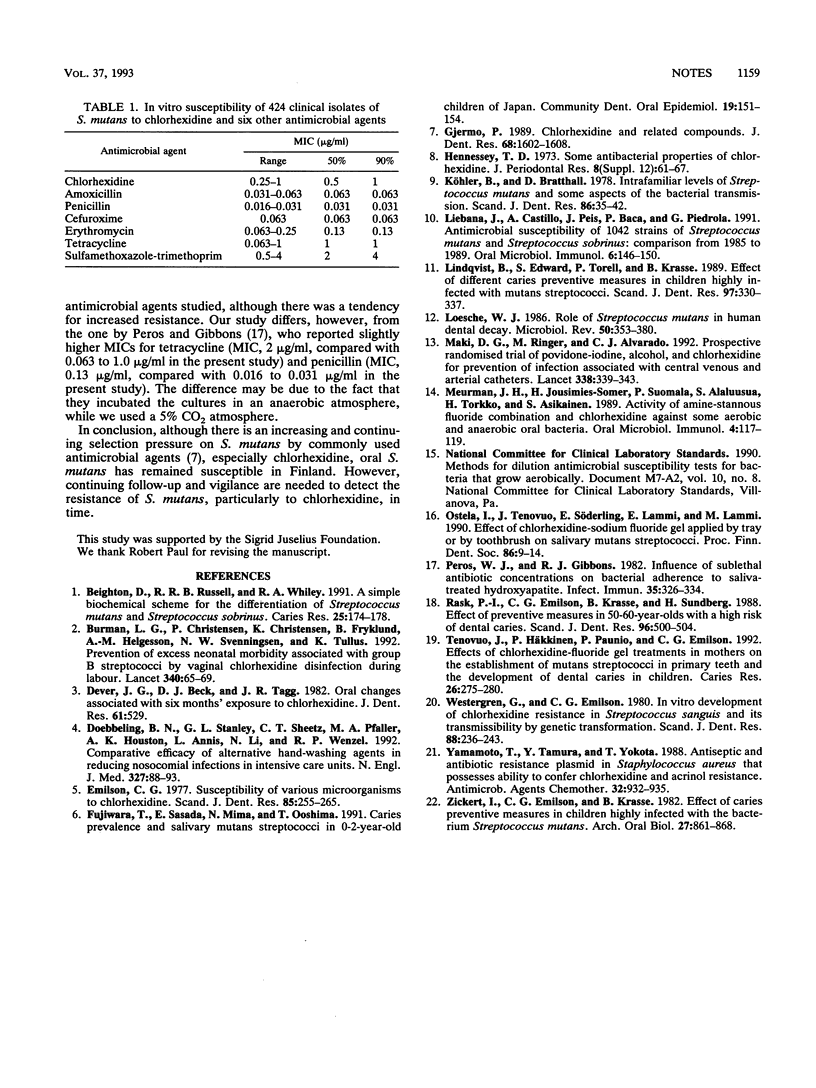Abstract
The susceptibility of Streptococcus mutans to chlorhexidine and to six commonly used, systemic antibacterial agents (amoxicillin, cefuroxime, penicillin, sulfamethoxazole-trimethoprim, tetracycline, and erythromycin) was studied for 424 clinical isolates from 116 children and students. The MIC of chlorhexidine for all isolates was < or = 1 micrograms/ml. No resistance to the other antimicrobial agents was detected. Although widely exposed to various antimicrobial agents, S. mutans has remained susceptible to common antimicrobial agents, most importantly to chlorhexidine.
Full text
PDF

Selected References
These references are in PubMed. This may not be the complete list of references from this article.
- Beighton D., Russell R. R., Whiley R. A. A simple biochemical scheme for the differentiation of Streptococcus mutans and Streptococcus sobrinus. Caries Res. 1991;25(3):174–178. doi: 10.1159/000261363. [DOI] [PubMed] [Google Scholar]
- Burman L. G., Christensen P., Christensen K., Fryklund B., Helgesson A. M., Svenningsen N. W., Tullus K. Prevention of excess neonatal morbidity associated with group B streptococci by vaginal chlorhexidine disinfection during labour. The Swedish Chlorhexidine Study Group. Lancet. 1992 Jul 11;340(8811):65–69. doi: 10.1016/0140-6736(92)90393-h. [DOI] [PubMed] [Google Scholar]
- Doebbeling B. N., Stanley G. L., Sheetz C. T., Pfaller M. A., Houston A. K., Annis L., Li N., Wenzel R. P. Comparative efficacy of alternative hand-washing agents in reducing nosocomial infections in intensive care units. N Engl J Med. 1992 Jul 9;327(2):88–93. doi: 10.1056/NEJM199207093270205. [DOI] [PubMed] [Google Scholar]
- Emilson C. G. Susceptibility of various microorganisms to chlorhexidine. Scand J Dent Res. 1977 May;85(4):255–265. doi: 10.1111/j.1600-0722.1977.tb00561.x. [DOI] [PubMed] [Google Scholar]
- Fujiwara T., Sasada E., Mima N., Ooshima T. Caries prevalence and salivary mutans streptococci in 0-2-year-old children of Japan. Community Dent Oral Epidemiol. 1991 Jun;19(3):151–154. doi: 10.1111/j.1600-0528.1991.tb00131.x. [DOI] [PubMed] [Google Scholar]
- Hennessey T. S. Some antibacterial properties of chlorhexidine. J Periodontal Res Suppl. 1973;12:61–67. doi: 10.1111/j.1600-0765.1973.tb02166.x. [DOI] [PubMed] [Google Scholar]
- Köhler B., Bratthall D. Intrafamilial levels of Streptococcus mutans and some aspects of the bacterial transmission. Scand J Dent Res. 1978 Jan;86(1):35–42. doi: 10.1111/j.1600-0722.1978.tb00605.x. [DOI] [PubMed] [Google Scholar]
- Liebana J., Castillo A., Peis J., Baca P., Piedrola G. Antimicrobial susceptibility of 1042 strains of Streptococcus mutans and Streptococcus sobrinus: comparison from 1985 to 1989. Oral Microbiol Immunol. 1991 Jun;6(3):146–150. doi: 10.1111/j.1399-302x.1991.tb00469.x. [DOI] [PubMed] [Google Scholar]
- Lindquist B., Edward S., Torell P., Krasse B. Effect of different carriers preventive measures in children highly infected with mutans streptococci. Scand J Dent Res. 1989 Aug;97(4):330–337. doi: 10.1111/j.1600-0722.1989.tb01620.x. [DOI] [PubMed] [Google Scholar]
- Loesche W. J. Role of Streptococcus mutans in human dental decay. Microbiol Rev. 1986 Dec;50(4):353–380. doi: 10.1128/mr.50.4.353-380.1986. [DOI] [PMC free article] [PubMed] [Google Scholar]
- Maki D. G., Ringer M., Alvarado C. J. Prospective randomised trial of povidone-iodine, alcohol, and chlorhexidine for prevention of infection associated with central venous and arterial catheters. Lancet. 1991 Aug 10;338(8763):339–343. doi: 10.1016/0140-6736(91)90479-9. [DOI] [PubMed] [Google Scholar]
- Meurman J. H., Jousimies-Somer H., Suomala P., Alaluusua S., Torkko H., Asikainen S. Activity of amine-stannous fluoride combination and chlorhexidine against some aerobic and anaerobic oral bacteria. Oral Microbiol Immunol. 1989 Jun;4(2):117–119. doi: 10.1111/j.1399-302x.1989.tb00109.x. [DOI] [PubMed] [Google Scholar]
- Ostela I., Tenovuo J., Söderling E., Lammi E., Lammi M. Effect of chlorhexidine-sodium fluoride gel applied by tray or by toothbrush on salivary mutans streptococci. Proc Finn Dent Soc. 1990;86(1):9–14. [PubMed] [Google Scholar]
- Peros W. J., Gibbons R. J. Influence of sublethal antibiotic concentrations on bacterial adherence to saliva-treated hydroxyapatite. Infect Immun. 1982 Jan;35(1):326–334. doi: 10.1128/iai.35.1.326-334.1982. [DOI] [PMC free article] [PubMed] [Google Scholar]
- Rask P. I., Emilson C. G., Krasse B., Sundberg H. Effect of preventive measures in 50-60-year-olds with a high risk of dental caries. Scand J Dent Res. 1988 Dec;96(6):500–504. doi: 10.1111/j.1600-0722.1988.tb01589.x. [DOI] [PubMed] [Google Scholar]
- Tenovuo J., Häkkinen P., Paunio P., Emilson C. G. Effects of chlorhexidine-fluoride gel treatments in mothers on the establishment of mutans streptococci in primary teeth and the development of dental caries in children. Caries Res. 1992;26(4):275–280. doi: 10.1159/000261451. [DOI] [PubMed] [Google Scholar]
- Westergren G., Emilson C. G. In vitro development of chlorhexidine resistance in Streptococcus sanguis and its transmissibility by genetic transformation. Scand J Dent Res. 1980 Jun;88(3):236–243. doi: 10.1111/j.1600-0722.1980.tb01220.x. [DOI] [PubMed] [Google Scholar]
- Yamamoto T., Tamura Y., Yokota T. Antiseptic and antibiotic resistance plasmid in Staphylococcus aureus that possesses ability to confer chlorhexidine and acrinol resistance. Antimicrob Agents Chemother. 1988 Jun;32(6):932–935. doi: 10.1128/aac.32.6.932. [DOI] [PMC free article] [PubMed] [Google Scholar]
- Zickert I., Emilson C. G., Krasse B. Effect of caries preventive measures in children highly infected with the bacterium Streptococcus mutans. Arch Oral Biol. 1982;27(10):861–868. doi: 10.1016/0003-9969(82)90042-5. [DOI] [PubMed] [Google Scholar]


